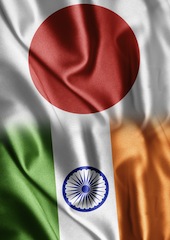India and Japan: Partners in Regional Stability?
Can India and Japan become bookends in Asia for regional stability?
August 9, 2013

While the India-China relationship may be one of the defining relationships for Asia in the 21st century, a closer collaboration between India and Japan could become one of the most important partnerships for the region.
Contrary to widespread belief in India that a large part of strategic planning in China is aimed at India, it is Japan that is the greater focus for Chinese analysts.
In Chinese media, it is also Japan, rather than India, that is the target of choice when nationalistic fervor is to be raised.
But that doesn’t mean the Chinese would not be prepared to envelop India in purported Japanese-made schemes.
Liu Zongyi from the Shanghai Institutes for International Studies, writing for China’s Global Times accused Japan of attempting to forge alliances with India and other neighbors to “encircle China” while India was warned of getting close to Japan at “its own peril.”
Chinese encirclement fears notwithstanding, cooperation between India and Japan could underpin the stability and security of the region.
India and Japan are complementary in some obvious ways: India is an emerging economy with a huge potential market. It is, however, constrained by inadequate capital and technology, which is precisely what Japan can provide.
On that road toward closer relations there are bound to be disappointments. One example is Japan’s lowered enthusiasm for a civil nuclear deal, which is well understood by Indian diplomats.
With the Fukushima incident still fresh in public memory, it does not help that India has not signed on to the non-proliferation treaty.
That makes any potential civilian nuclear deal a difficult sell in the only country that has suffered the full effects of the atomic weapon.
At the same time, the Fukushima incident points to new indirect avenues of collaboration. As the Japanese public demands lower dependence on nuclear energy, the Japanese government will look for fossil fuels to meet the energy demands, mostly from the Middle East.
To this end, maritime security will be critical to ensure the safe passage of cargo ships in the Indian Ocean and on to Japan.
Greater cooperation between the two countries’ navies and coast guards could over time encompass sharing of defense technologies. This would be a way of taking forward the 2008 Declaration on Security Cooperation.
India and Japan could also collaborate on the development of Myanmar. As Myanmar seeks to balance its dependence on China, Japan and India are natural potential partners, along with other ASEAN countries.
They have a strategic interest in seeing the country move to greater democracy and economic development.
China’s investments are, predictably enough, mainly in Myanmar’s resource extraction industries.
In contrast, Japan has expressed interest in helping to develop the country’s infrastructure and manufacturing sector.
Meanwhile, India has displayed competence in the telecom, information technology and pharmaceutical sectors and could help there.
The current hot topic of Myanmar aside, the “low hanging fruit” of the India-Japan partnership continues to be the expansion of trade and investments between the two countries.
It is expected to reach $25 billion in 2014, dwarfed by trade between Japan and China at over $300 billion. The 800 odd Japanese firms operating in India also pale in comparison to the approximately 22,300 Japanese firms in China.
Even so, as an Ernst and Young 2012 study noted, Japan is already the second largest foreign job creator in India, after the United States.
While a majority of the earlier investments went to the auto and auto parts sectors, new investments are more diversified and include pharmaceuticals, securities and food.
Japan has also invested in the Delhi Mumbai Industrial Corridor (DMIC) project and is keen to develop a high-speed railway system in India.
A Japanese Bank for International Cooperation (JBIC) survey on “Ranking for Promising Countries for Overseas Operations over the Long-term” by Japanese companies placed India at the top, while Myanmar came in at number 8.
Recently, Japan signed a memorandum of understanding to enable the import of rare-earth minerals from India.
This move that will help Tokyo reduce its heavy reliance on China for the key resources used to manufacture high-tech products.
Japan imported around 90% of its rare-earth supplies from China last year and is hoping to reduce its dependence amidst Beijing’s curb on exports following tension between the two countries.
For all the potential, many Japanese businessmen and policy makers still find doing business in India an enormous challenge.
Large numbers of Japanese companies cite the lack of adequate infrastructure, difficulties in employment and personnel management, increases in procurement and production costs and poor quality control mechanisms as some of the major difficulties.
Maruti Suzuki, the flagship India-Japan joint venture in the car industry, has faced immense labor problems since the summer of 2012. India needs to fix these crucial gaps if it is to continue attracting foreign investments.
Of course, Japan also needs to do its part, mainly by opening up its market to Indian goods and services, providing for a two way exchange.
The tasks that lie ahead for Japan are clear.
Shinzo Abe seeks to put the Japanese economy back on a better footing. For that, he will need to tone down his anti-China rhetoric.
Otherwise, China, which continues to be a major trading partner for both Japan and India, may view the cooperation as a ganging up of Japan and India against China’s rise.
The development of strong bilateral relations between India and Japan can have significant effects that go into the building of Japan’s proposed “arc of freedom and prosperity” across Eastern Europe, Central Asia, South Asia and East Asia.
If not, there is a danger that the Annual Summit Meetings of the Prime Ministers of India and Japan, such as the most recently held on May 2013 in Tokyo, may end up as little more than an annual ritual in niceties.
Takeaways
India's belief is that China's strategic planning is aimed at India, but Japan is China's greater focus.
Japan is already the second largest foreign job creator in India.
Japan is keen to develop a high-speed railway system in India.
Japanese businessmen and policymakers still find doing business in India an enormous challenge.
With Abe's rhetoric, China may view cooperation as a ganging up of Japan and India against its rise.
Development of strong bilateral ties between India and Japan may build an "arc of freedom and prosperity."
Read previous

Energy Security: Asia’s Achilles Heel
August 7, 2013
